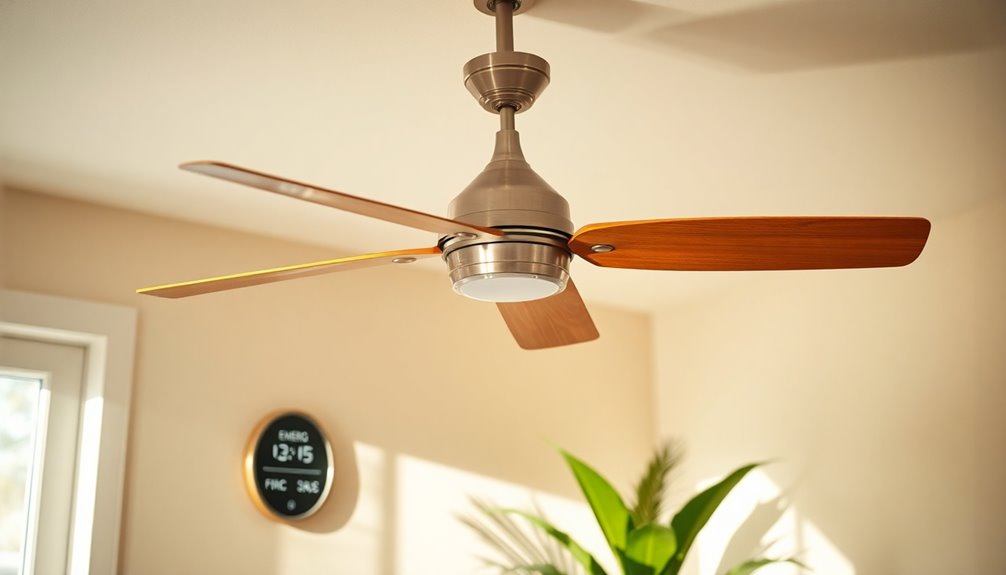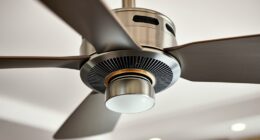Vaulted ceilings don’t automatically guarantee good airflow. While high, open spaces seem perfect for natural ventilation, actual air movement depends on factors like vent placement, shape, and pressure differences. Physics shows that proper airflow relies on strategic design and airflow principles, not just height or aesthetics. Understanding these principles can help you optimize your space. Keep exploring, and you’ll discover how science can improve comfort and efficiency in vaulted ceilings.
Key Takeaways
- Myth: High vaulted ceilings alone ensure good airflow; in reality, ventilation depends on vents, fans, and pressure differences.
- Math: Air moves from high to low pressure, with flow rate influenced by vent size, placement, and pressure gradients.
- Myth: Warm air rising naturally ventilates vaulted ceilings; proper airflow requires strategic vent placement and design features.
- Math: Taller ceilings create larger air volumes, which can reduce stagnation if combined with effective airflow strategies like ridge and soffit vents.
- Myth: Aesthetic vaulted designs hinder ventilation; with proper calculations and CFD data, airflow can be optimized without compromising style.
The Common Assumptions About Vaulted Ceiling Ventilation

Many people assume that vaulted ceilings naturally promote better airflow because of their height and open design. This belief fuels airflow misconceptions, leading many to think ventilation happens effortlessly in such spaces. They assume warm air rises and escapes easily through high ceilings, creating a natural cooling effect. However, ventilation myths like this overlook how airflow actually works in vaulted ceilings. Simply having high ceilings doesn’t guarantee proper airflow or ventilation. Without proper design features like vents or fans, air can become stagnant, causing hot spots and poor air quality. It’s a common misconception that height alone improves ventilation, but real airflow depends on factors like pressure differences, vents placement, and air movement strategies. Proper ventilation requires understanding airflow fundamentals and implementing effective solutions—height alone doesn’t guarantee good air circulation. Effective airflow solutions are essential to ensure proper ventilation in vaulted ceiling spaces. Don’t rely solely on the ceiling height—proper ventilation planning matters more. Additionally, understanding ventilation mechanisms can significantly improve air circulation and indoor air quality.
The Physics of Airflow: Basic Principles and Equations

Understanding how air moves in vaulted ceilings starts with pressure and flow dynamics. You’ll see how differences in pressure cause air to circulate and how flow rates are affected. Bernoulli’s principle then explains how changes in air speed relate to pressure variations, shaping airflow patterns. Additionally, air circulation efficiency depends on the design and height of the ceiling, influencing overall airflow behavior. Factors like ceiling height can significantly impact how effectively air circulates within the space. Moreover, the airflow patterns are affected by the presence of openings or vents, which facilitate or hinder movement.
Pressure and Flow Dynamics
Airflow in vaulted ceilings is governed by fundamental principles of physics that describe how air moves in response to pressure differences. You might have seen ventilation misconceptions that oversimplify airflow, but understanding these dynamics is essential. Key factors include:
- Pressure differences drive airflow—air moves from high to low pressure, creating natural circulation.
- Flow rate depends on the pressure gradient—greater differences result in faster airflow.
- Obstructions and opening sizes influence flow—these factors can disrupt or enhance air movement.
- Community resilience plays a crucial role in maintaining effective airflow during emergencies, ensuring proper ventilation even in challenging conditions.
Bernoulli’s Principle Explained
Bernoulli’s Principle explains how variations in fluid speed affect pressure within airflow, providing a fundamental insight into how air moves in vaulted ceilings. As air speeds up along curves or narrow spaces, pressure decreases, shaping airflow patterns. Conversely, slower-moving air experiences higher pressure. These pressure differentials drive air from high-pressure zones to low-pressure areas, influencing ventilation and comfort in vaulted spaces. Understanding this principle helps you visualize how warm air rises and circulates, creating natural airflow loops. When airflow accelerates along the vaulted ceiling, pressure drops, causing air to move and mix more efficiently. Recognizing these dynamics allows you to better predict and optimize airflow behavior, ensuring proper ventilation and indoor air quality in spaces with vaulted ceilings. Additionally, the pressure differences created by Bernoulli’s Principle play a crucial role in maintaining effective airflow and temperature regulation within such architectural structures.
How Ceiling Height and Shape Influence Air Movement

The height and shape of a vaulted ceiling play a crucial role in directing how air moves through a space. Taller ceilings and unique shapes influence air circulation patterns and aesthetic considerations. Here are three key effects:
- Enhanced Air Movement: Increased height creates larger air volumes, promoting better circulation and reducing stagnant zones.
- Flow Direction: The shape, such as a curved or pointed vault, guides airflow along specific paths, impacting comfort.
- Visual Impact: Aesthetic considerations come into play, as the ceiling’s form can make a room feel more spacious while affecting how air interacts with the environment. Incorporating crochet styles for locs can also add a decorative touch that complements the room’s design.
The Role of Buoyancy and Thermal Stratification

Buoyancy, driven by temperature differences within a vaulted ceiling space, markedly influences how air moves vertically. When warm air rises due to thermal buoyancy, it creates stratification layering, where warmer air sits above cooler air. This layering can lead to uneven temperature distribution, impacting comfort and energy efficiency. You’ll notice that as heat accumulates near the ceiling, it tends to stay trapped if there’s insufficient airflow, reinforcing stratification. Understanding how thermal buoyancy works helps you grasp why hot air rises and how temperature gradients develop in vaulted ceilings. Proper ventilation plays a crucial role in mitigating these effects by promoting air mixing and preventing excessive stratification. Managing these effects involves recognizing that buoyancy naturally encourages vertical air movement, but without proper ventilation or design considerations, stratification layering can hinder effective airflow and temperature regulation. Additionally, advancements in building science focus on developing ventilation strategies that effectively reduce stratification and improve overall indoor climate, which can also influence energy efficiency in vaulted spaces.
Impact of Vent Placement and Design Features

Where you place vents can substantially influence airflow patterns in your vaulted ceiling. The location determines how effectively warm air escapes and cool air enters, impacting comfort and energy efficiency. Design features, like vent size and shape, also play a crucial role in optimizing circulation. Additionally, selecting efficient ventilation options can further enhance airflow performance and indoor climate control. Proper vent placement can also prevent issues such as stratification, which can lead to uneven temperature distribution and increased energy costs. Implementing AI-driven analytics can help optimize vent placement based on real-time environmental data to improve overall airflow.
Vent Location Effects
Have you ever wondered how the placement and design of vents influence airflow in vaulted ceilings? Proper vent location directly impacts airflow patterns and vent efficiency. Here are three key effects:
- High-mounted vents promote vertical airflow, helping warm air escape and cool air circulate. Proper placement enhances AI security by optimizing airflow and preventing stagnation. Additionally, understanding vent placement strategies can significantly improve ventilation effectiveness.
- Proximity to windows or doors can disrupt airflow, causing uneven temperature distribution.
- Strategic placement near the roof apex enhances exhaust, improving overall ventilation.
- Ensuring vents are properly categorized according to their function maximizes their effectiveness in maintaining balanced airflow.
If vents are poorly positioned, airflow becomes inefficient, leading to hot spots or stale air. Correct placement guarantees consistent air movement and temperature control, maximizing vent efficiency. By understanding how vent location affects airflow patterns, you can optimize your vaulted ceiling’s ventilation system for better comfort and energy savings.
Design Element Influences
The placement and design features of vents considerably shape airflow patterns within vaulted ceilings. Properly designed vents optimize airflow, improving ceiling acoustics and maintaining aesthetic appeal. For example, vents positioned near the peak promote vertical airflow, reducing stagnant air and drafts. Design features like grille style, size, and placement influence both function and appearance, blending seamlessly with your space. Consider the table below to see how different vent styles affect airflow and aesthetics:
| Vent Style | Airflow Efficiency | Aesthetic Appeal |
|---|---|---|
| Linear Grilles | High | Modern, sleek |
| Diffusers | Moderate | Discreet |
| Decorative Vents | Variable | Artistic, stylish |
| Ridge Vents | Good | Minimalist |
| Return Vents | Essential | Functional |
Choosing the right design element elevates ceiling acoustics and overall visual harmony. Additionally, understanding the impact of vent placement can help maximize airflow efficiency and aesthetic integration, especially when considering airflow dynamics and how they interact with your ceiling’s architecture. Properly managing airflow in vaulted ceilings is essential to prevent issues like uneven temperature distribution and moisture buildup, which can affect both comfort and durability.
Computational Fluid Dynamics: Modeling Airflow in Vaulted Spaces

Computational Fluid Dynamics (CFD) offers a powerful approach to understanding airflow patterns in vaulted ceilings, enabling detailed analysis that was previously difficult to achieve. By simulating airflow, you can evaluate how historical architecture and aesthetic considerations influence ventilation and comfort. With CFD, you can:
- Visualize complex air movement around architectural features
- Identify areas of poor airflow or stagnation
- Optimize designs to balance historic charm with modern efficiency
This technology helps you see how vaulted ceilings affect air distribution, ensuring your space remains comfortable without compromising its aesthetic appeal. CFD tools provide insights that were once inaccessible, allowing you to make informed decisions that respect both the architecture’s heritage and the need for effective ventilation.
Real-World Data: Measuring Airflow and Temperature Variations

Real-world data collection provides tangible insights into airflow and temperature variations within vaulted ceilings, complementing CFD models with actual performance measurements. By measuring airflow patterns and temperature differences directly, you can better understand how vaulted designs influence humidity control and acoustic considerations. For example, uneven airflow can lead to areas with higher humidity, risking mold growth, or cause temperature inconsistencies that affect comfort. Monitoring these variables helps identify issues that models might overlook, ensuring that ventilation strategies effectively address airflow challenges. Additionally, real-world data highlights how architectural features impact sound transmission and absorption, essential for acoustic considerations. Collecting this data allows you to fine-tune systems for ideal humidity regulation, temperature stability, and acoustic performance, making your vaulted space both comfortable and functional.
Strategies for Enhancing Ventilation in Vaulted Ceilings

To improve airflow in vaulted ceilings, implementing effective ventilation strategies is essential. You can consider these approaches:
- Install ridge vents to facilitate natural convection, respecting the historical architecture and maintaining aesthetic considerations.
- Add soffit vents to promote continuous airflow from the eaves, enhancing comfort without compromising visual appeal.
- Use attic fans or exhaust vents strategically placed to improve air exchange, blending modern technology with the building’s design.
These strategies balance functionality with aesthetic considerations, preserving the charm of historical architecture while optimizing ventilation. Proper placement and design guarantee airflow improves without disrupting the visual harmony. By focusing on these methods, you enhance comfort and energy efficiency, making your vaulted ceiling both beautiful and well-ventilated.
Debunking Myths: What Science Reveals About Ventilation and Comfort

Many common beliefs about ventilation and comfort are actually myths that science has debunked. For example, some think that vaulted ceilings naturally improve airflow and reduce temperature issues, but studies show that without proper ventilation, these spaces can trap hot air, decreasing HVAC efficiency. You might assume that increasing airflow always boosts comfort, yet excessive or poorly directed airflow can create drafts and discomfort. Additionally, some believe that vaulted ceilings sacrifice aesthetic appeal for comfort; in reality, with smart ventilation and design, you can enhance both. Science reveals that optimizing airflow patterns and ventilation strategies improves HVAC efficiency, leading to better comfort without compromising the visual impact of vaulted ceilings. Understanding these truths helps you make informed decisions for your home’s airflow and design.
Frequently Asked Questions
How Does Humidity Affect Airflow in Vaulted Ceilings?
Humidity effects play a significant role in airflow dynamics in vaulted ceilings. Higher humidity levels can make the air heavier, reducing natural airflow and causing moisture buildup near the ceiling. This can lead to poor ventilation and potential mold growth. Conversely, lower humidity improves airflow, helping to circulate air more efficiently and maintain a balanced indoor environment. Understanding these humidity effects helps you optimize your home’s ventilation and prevent issues related to moisture.
Can Natural Ventilation Sufficiently Cool Large Vaulted Spaces?
Imagine a large vaulted hall relying solely on natural ventilation during summer. You might find that airflow alone isn’t enough to maintain thermal comfort, especially on hot days. Natural ventilation can improve air circulation, but it often falls short of cooling large vaulted spaces effectively. To guarantee comfort, you may need supplemental strategies like fans or insulation, as natural airflow alone may not provide sufficient thermal comfort in such expansive areas.
What Are the Environmental Impacts of Different Ventilation Strategies?
When choosing ventilation strategies, you impact air quality and energy efficiency. Natural ventilation can improve air quality by reducing indoor pollutants, but may fall short in extreme weather. Mechanical systems boost control and energy efficiency, yet consume more energy. Properly balancing these strategies helps you reduce environmental impacts, lowers energy use, and maintains healthy indoor air quality, ensuring a sustainable and comfortable space.
How Do Seasonal Changes Influence Airflow Patterns?
Seasonal changes markedly influence airflow patterns by affecting thermal stratification and air exchange. In winter, cooler outdoor air causes warm air to rise, creating stratification that limits airflow at lower levels. During summer, increased temperatures enhance air exchange, promoting better circulation. You’ll notice these shifts in airflow; understanding them helps optimize ventilation strategies, ensuring comfort and energy efficiency regardless of seasonal variations.
Are There Innovative Materials That Improve Ventilation Efficiency?
Imagine using aerogel insulation in a home with vaulted ceilings; this innovative material enhances ventilation efficiency by reducing heat transfer and promoting better airflow. Such materials, like phase-change materials or advanced composites, improve ventilation efficiency by optimizing airflow and temperature regulation. They’re transforming building design, making spaces more comfortable and energy-efficient. You can harness these innovations to upgrade your ventilation system, ensuring better air quality and lower energy costs throughout the year.
Conclusion
Think of your vaulted ceiling as a vast sky, where airflow is the wind shaping comfort. By understanding the science behind it, you can guide this breeze to flow smoothly, avoiding stagnant air and temperature extremes. Don’t just rely on myths—trust the math. When you align design and ventilation like a gentle breeze guiding a leaf, you create a sanctuary where airflow lifts your comfort, turning a lofty space into a haven of harmony.









